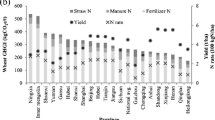Abstract
China is a major producer of wheat, maize and rice, which generates massive greenhouse gas emissions due to the consumption of elevated amounts of energy, land, and water, yet there is actually few knowledge on the spatial heterogeneity of greenhouse gas emissions. Here, we introduce a polyphasic approach to quantify the emissions from the land, energy, and water in Chinese cereal production. Results show that total greenhouse gas emissions from wheat, maize and rice crops reached 505.5 Tg CO2eq, including 247.5 Tg CO2eq for the land, 222.1 Tg CO2eq for energy, and 35.9 Tg CO2eq for water. The major greenhouse gas contributors are the land, of 55.8%, and energy to produce nitrogen fertilizers, of 30.5%. Moreover, greenhouse gas emissions from cereal production show large-scale spatial heterogeneity at the provincial scale due to differences in crop type, natural resources, and managerial practices. The collective adoption of green technologies and reasonable food trading practices could reduce greenhouse gas emissions from the cereal production supply chain, further promoting the carbon neutrality of agriculture.



Similar content being viewed by others
References
China Rural Statistical Yearbook (2013) China Statistics Press, Beijing, 2012
Cui XQ, Shang ZY, Xia LL, Xu RT, Adalibieke W, Zhan XY, Smith P, Zhou F (2022) Deceleration of cropland-N2O emissions in China and future mitigation potentials. Environ Sci Technol 56(7):4665–4675
Fan X, Zhang W, Chen WW, Chen B (2020) Land-water-energy nexus in agricultural management for greenhouse gas mitigation. Appl Energ 265:114796
Foley JA, Ramankutty N, Brauman KA et al (2011) Solutions for a Cultivated Planet Nat 478:337–342
Frank S, Havlík P, Stehfest E et al (2019) Agricultural non-CO2 emission reduction potential in the context of the 1.5 °C target. Nat Clim Change 9:66–72
Gao B, Huang T, Ju XT, Gu BJ, Huang W, Xu LL, Rees RM, Powlson DS, Smith P, Cui SH (2018) Chinese cropping systems are a net source of greenhouse gases despite soil carbon sequestration. Glob Change Biol 24:5590–5606
Horton P, Long SP, Smith P, Banwart SA, Beerling DJ (2021) Technologies to deliver food and climate security through agriculture. Nat Plants 7:250–255
IPCC (2014) Climate Change. In: Edenhofer O et al (eds) Mitigation of Climate Change. Cambridge Univ Press, UK
Liu YZ, Gu WY, Liu BB, Zhang B, Wang C, Yang Y, Zhuang MH (2022) Closing greenhouse gas emission gaps of staple crops in China. Environ Sci Technol 56(13):9302–9311
Mueller ND, Gerber JS, Johnston M, Ray DK, Ramankutty N, Foley JA (2012) Closing yield gaps through nutrient and water management. Nat 490:254–257
NDRCC (2012) The people’s republic of China national greenhouse gas inventory (2005). China Environmental Science Press
Sun G, Sun M, Du LS, Zhang Z, Wang ZC, Zhang GB, Nie SA, Xu HQ, Wang H (2021) Ecological rice-cropping systems mitigate global warming-A meta-analysis. Sci Total Environ 789:147900
Wang JX, Rothausen SGSA, Conway D, Zhang LJ, Xiong W, Holman IP, Li YM (2012) China’s water-energy nexus: greenhouse-gas emissions from groundwater use for agriculture. Environ Res Lett 7:014035
Xia LL, Ti CP, Li BL, Xia YQ, Yan XY (2016) Greenhouse gas emissions and reactive nitrogen releases during the life-cycles of staple food production in China and their mitigation potential. Sci Total Environ 556:116–125
Xia LL, Lam SK, Chen DL, Wang JY, Tang Q, Yan XY (2017) Can knowledge-based N management produce more staple grain with lower greenhouse gas emission and reactive nitrogen pollution? A meta-analysis. Glob Change Biol 23:1917–1925
Xia LL, Yan XY, Cai ZC (2020) Research progress and prospect of greenhouse gas mitigation and soil carbon sequestration in croplands of China. J Agro-Environ Sci 39(4):834–841 (in Chinese with English Abstract)
Yan XY, Akiyama H, Yagi K, Akimoto H (2009) Global estimations of the inventory and mitigation potential of methane emissions from rice cultivation conducted using the 2006 Intergovernmental Panel on Climate Change Guidelines. Glob Biogeochem Cycles 23: 20–23
Zhang G, Wang XK, Zhang L, Xiong KN, Zheng CY, LuF ZH, Zheng H, Ouyang ZY (2018) Carbon and water footprints of major cereal crops production in China. J Clean Prod 194:613–623
Zhao RQ, Liu Y, Tian MM, Ding ML, Cao LH, Zhang ZP, Chua XW, Xiao LG, Yao LG (2018) Impacts of water and land resources exploitation on agricultural carbon emissions: The water-land-energy-carbon nexus. Land Use Policy 72:480–492
Zhuang MH, Liu YZ, Yang Y, Zhang QS, Ying H, Yin YL, Cui ZL (2022) The sustainability of staple crops in China can be substantially improved through localized strategies. Renew Sust Energ Rev 154:111893
Acknowledgements
This study was financially supported by the National Natural Science Foundation of China (41901241), the Open Research Fund Program of State Environmental Protection Key Laboratory of Food Chain Pollution Control (FC2021YB07), the Chinese Universities Scientific Fund (2022TC096) and the State Environmental Protection Key Laboratory of Sources and Control of Air Pollution Complex (SCAPC202102).
Funding
This study was financially supported by the National Natural Science Foundation of China (41901241), the Open Research Fund Program of State Environmental Protection Key Laboratory of Food Chain Pollution Control (FC2021YB07), the Chinese Universities Scientific Fund (2022TC096) and the State Environmental Protection Key Laboratory of Sources and Control of Air Pollution Complex (SCAPC202102).
Author information
Authors and Affiliations
Corresponding authors
Ethics declarations
Conflict of interest
The authors declare no conflict of interest.
Additional information
Publisher's Note
Springer Nature remains neutral with regard to jurisdictional claims in published maps and institutional affiliations.
Supplementary Information
Below is the link to the electronic supplementary material.
Rights and permissions
Springer Nature or its licensor holds exclusive rights to this article under a publishing agreement with the author(s) or other rightsholder(s); author self-archiving of the accepted manuscript version of this article is solely governed by the terms of such publishing agreement and applicable law.
About this article
Cite this article
Zhuang, M., Caro, D., Qin, W. et al. Spatial heterogeneity of greenhouse gas emissions from cereal crop production in China. Environ Chem Lett 20, 3371–3376 (2022). https://doi.org/10.1007/s10311-022-01504-y
Received:
Accepted:
Published:
Issue Date:
DOI: https://doi.org/10.1007/s10311-022-01504-y




